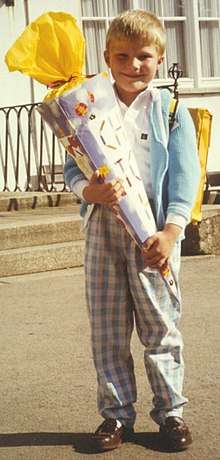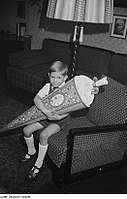Schultüte

A Schultüte (or school cone, even though the German word Tüte is translated into English in most other contexts as "bag" - see also Danish: Skolekræmmerhus or Skolepose), is a large cone-shaped container made of paper or cardboard or plastic.
When children in Germany, in parts of the Czech Republic close to the German border,[1] in parts of Poland (Greater Poland, Upper Silesia, Warmia), in Austria, and in the German-speaking parts of Switzerland or Belgium set off for their first day of school upon entering first grade, their parents and/or grandparents present them with a large cardboard cone, attractively decorated and filled with toys, chocolate, candies/sweets, school supplies, and various other special treats. The cone is given to children to make this anxiously awaited first day of school a little sweeter.
 Girl with a Schultüte, 1953
Girl with a Schultüte, 1953 Boy with a Schultüte, in Leipzig, 1951
Boy with a Schultüte, in Leipzig, 1951 Schultüte on table
Schultüte on table
History
The tradition of the Schultüte has its origins in approximately the year 1810 in the regions Saxony, Saxony-Anhalt and Thuringia in Germany[2]. The first documented report of the cone-shaped Schultüte comes from the city of Jena in 1817,[3] closely followed by reports from Dresden (1820) and Leipzig (1836). It started in the larger cities but spread quickly to small towns and villages, soon becoming an institution all over Germany.
In the early days of the concept of the Schultüte, before it spread to other parts of Germany, the usual routine was not to hand over the cone to the children personally. Marked with the students' names, the cones were taken to the school by grandparents or godparents and in a ritual reminiscent of the Mexican piñata, they were hung on a metal Schultüten-Baum (school-cone tree) from which each child had to pick his or her cone, without breaking it. The story told to the children claimed that there was a Schultütenbaum growing at the school, and if that tree's fruits (i.e. the Schultüten) were ripe and large enough to pick, it was then time to go to school for the first time.
The only custom that changed in the latter half of the 20th century is that fewer sweets seem to appear in the Schultüte, with more practical gifts such as crayons and pencils, small toys, CDs, books and even articles of clothing replacing the traditional chocolates and candies/sweets. These are traditionally given by grandparents who also take the child out to dinner the evening before school begins.
Christiane Cantauw, a German folklore expert at the Volkskundliche Kommission für Westfalen (Folkloristic Commission of Westphalia, based in the city of Münster), has researched the Schultüte tradition. In a 2016 interview with the broadcaster Deutsche Welle she explained how important the symbolism of the Schultüte tradition is for school beginners and their families, regardless of their financial means:[2]
| “ | The school cone is really just a container, which means you can't look inside of it. And it's not opened at school but afterwards at home. That means that if I'm financially not in a position to fill up the cone with presents, I can fill it out with extras. So people threw in potatoes or paper. In one instance, I read that a wooden shoe was put in the bottom of the cone. But we can see that this symbol for school beginners was so important that no one wanted to do without it. | ” |
| — Christiane Cantauw | ||
| Wikimedia Commons has media related to Schultüte. |
References
- ↑ "Kornout do první třídy". Centrum Pomoci rodinám s vícerčaty. Retrieved 18 February 2015.
- 1 2 Müser, Kate (23 August 2017). "Why Germans give their kids paper cones on the first day of school". DW. Deutsche Welle. Retrieved 18 January 2018.
- ↑ Jena City Museum Homepage, Exhibition about the first day at school (in German)